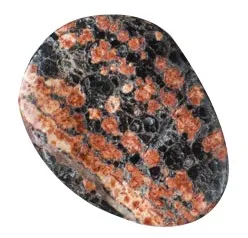
Red Snowflake Obsidian takes its name from the distinctive red inclusions that resemble delicate snowflake patterns scattered across its dark volcanic glass base. The term “obsidian” comes from the Roman explorer Obsidius, who reportedly discovered this volcanic glass in Ethiopia. Alternate names such as Fire Snowflake Obsidian and Iron Snowflake Obsidian highlight the iron-rich deposits responsible for its red-speckled appearance.
Composition & Physical Characteristics
Red Snowflake Obsidian forms as an igneous rock when felsic lava cools rapidly, halting crystal growth and producing a smooth, glassy texture.
- Colour: Black or grey base with red inclusions resembling snowflakes.
- Hardness: 5–5.5 on the Mohs scale, making it durable yet slightly softer than quartz.
- Texture: Vitreous, glassy finish with opaque inclusions.
- Formation: Created through volcanic activity, with iron deposits forming the red patterns.
Geographical Locations
Red Snowflake Obsidian is primarily found in Mexico, which produces some of the highest-quality specimens. Other deposits exist in regions with historic volcanic activity, including Italy, Scotland, the United States, and Japan.
Archaeological & Historical Significance
Ancient cultures crafted tools, weapons, and jewellery from obsidian, drawn to its sharp edges and enduring strength. In Mesoamerican civilisations, people prized it for both ritualistic and practical purposes, with archaeologists uncovering numerous artefacts at Mayan and Aztec sites. Today, crystal enthusiasts and collectors seek Red Snowflake Obsidian for its striking appearance and metaphysical benefits.
Interesting Facts
- Not a true mineral: Obsidian lacks a crystalline structure, making it a volcanic glass rather than a mineral.
- Used in surgical tools: Due to its ability to hold a razor-sharp edge, obsidian has been used in precision surgical scalpels.
- Ancient trade commodity: Obsidian was widely traded among early civilisations, with artefacts found far from their original sources.
Folklore, Superstition & Legends
Various traditions regard obsidian as a powerful protector, capable of warding off negativity and shielding against psychic attacks. Many cultures link Red Snowflake Obsidian with fire energy, embracing it as a symbol of transformation and rebirth. Practitioners value it for its ability to absorb negative energy, making it a potent ally for emotional cleansing.
Mystical Healing Properties & Zodiac Links
Red Snowflake Obsidian is linked to Capricorn and Virgo, offering grounding and stability.
- Emotional Healing: Helps release stress, anxiety, and emotional blockages.
- Protection & Grounding: Shields against negativity and stabilises emotions.
- Transformation & Growth: Encourages self-reflection and personal evolution.
Chakra System
Red Snowflake Obsidian primarily activates the Root Chakra, promoting grounding and security. It also resonates with the Solar Plexus Chakra, enhancing confidence and empowerment.
Use as a Birthstone & Wedding Anniversary Gift
Although not a traditional birthstone, many use Red Snowflake Obsidian as an alternative for January, embracing its connection to Capricorn’s grounding energy. People also regard it as a meaningful anniversary gift, celebrating resilience and transformation within relationships.
Crystal Pairings: What Works & What to Avoid
Best Pairings
- Hematite – Enhances grounding and stability.
- Amethyst – Supports emotional healing and clarity.
- Carnelian – Boosts motivation and energy.
Crystals to Avoid
- Malachite – Can amplify emotions too intensely.
- Clear Quartz – May overstimulate energy when combined with obsidian.
- Blue Lace Agate – Its calming energy may counteract obsidian’s grounding effects

Red snowflake obsidian
Red Snowflake Obsidian balances passion with calm, blending fiery energy and grounding clarity. A powerful stone for protection, release, and emotional healing.
